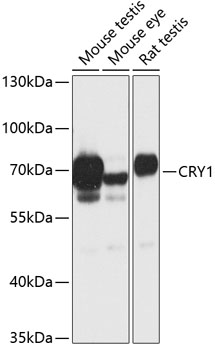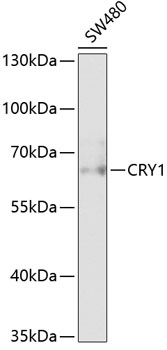Cell Biology Antibodies 4
Anti-CRY1 Antibody (CAB13662)
- SKU:
- CAB13662
- Product Type:
- Antibody
- Reactivity:
- Human
- Reactivity:
- Mouse
- Reactivity:
- Rat
- Host Species:
- Rabbit
- Isotype:
- IgG
- Antibody Type:
- Polyclonal Antibody
- Research Area:
- Cell Biology
Description
| Antibody Name: | Anti-CRY1 Antibody |
| Antibody SKU: | CAB13662 |
| Antibody Size: | 20uL, 50uL, 100uL |
| Application: | WB |
| Reactivity: | Human, Mouse, Rat |
| Host Species: | Rabbit |
| Immunogen: | Recombinant fusion protein containing a sequence corresponding to amino acids 1-255 of human CRY1 (NP_004066.1). |
| Application: | WB |
| Recommended Dilution: | WB 1:500 - 1:2000 |
| Reactivity: | Human, Mouse, Rat |
| Positive Samples: | Mouse testis, Mouse eye, Rat testis, SW480 |
| Immunogen: | Recombinant fusion protein containing a sequence corresponding to amino acids 1-255 of human CRY1 (NP_004066.1). |
| Purification Method: | Affinity purification |
| Storage Buffer: | Store at -20'C. Avoid freeze / thaw cycles. Buffer: PBS with 0.02% sodium azide, 50% glycerol, pH7.3. |
| Isotype: | IgG |
| Sequence: | MGVN AVHW FRKG LRLH DNPA LKEC IQGA DTIR CVYI LDPW FAGS SNVG INRW RFLL QCLE DLDA NLRK LNSR LFVI RGQP ADVF PRLF KEWN ITKL SIEY DSEP FGKE RDAA IKKL ATEA GVEV IVRI SHTL YDLD KIIE LNGG QPPL TYKR FQTL ISKM EPLE IPVE TITS EVIE KCTT PLSD DHDE KYGV PSLE ELGF DTDG LSSA VWPG GETE ALTR LERH LERK AWVA NFER PRMN ANSL LASP TGLS PYL |
| Gene ID: | 1407 |
| Uniprot: | Q16526 |
| Cellular Location: | Cytoplasm, Nucleus |
| Calculated MW: | 66kDa |
| Observed MW: | 70kDa |
| Synonyms: | CRY1, PHLL1, DSPD |
| Background: | This gene encodes a flavin adenine dinucleotide-binding protein that is a key component of the circadian core oscillator complex, which regulates the circadian clock. This gene is upregulated by CLOCK/ARNTL heterodimers but then represses this upregulation in a feedback loop using PER/CRY heterodimers to interact with CLOCK/ARNTL. Polymorphisms in this gene have been associated with altered sleep patterns. The encoded protein is widely conserved across plants and animals. Loss of the related gene in mouse results in a shortened circadian cycle in complete darkness. |
| UniProt Protein Function: | CRY1: Blue light-dependent regulator of the circadian feedback loop. Inhibits CLOCK|NPAS2-ARNTL E box-mediated transcription. Acts, in conjunction with CRY2, in maintaining period length and circadian rhythmicity. Has no photolyase activity. Capable of translocating circadian clock core proteins such as PER proteins to the nucleus. May inhibit CLOCK|NPAS2-ARNTL transcriptional activity through stabilizing the unphosphorylated form of ARNTL. Component of the circadian core oscillator, which includes the CRY proteins, CLOCK or NPAS2, ARNTL or ARNTL2, CSNK1D and/or CSNK1E, TIMELESS, and the PER proteins. Interacts directly with TIMELESS and the PER proteins. Interacts directly with PER1 and PER2 C-terminal domains. Interaction with PER2 inhibits its ubiquitination and vice versa. Binds MAPK. Interacts with FBXL21. Interacts with FBXL3. Expression is regulated by light and circadian rhythms. Peak expression in the suprachiasma nucleus (SCN) and eye at the day/night transition (CT12). Levels decrease with ARNTL-CLOCK inhibition as part of the autoregulatory feedback loop. Belongs to the DNA photolyase class-1 family. |
| UniProt Protein Details: | Protein type:DNA-binding; Transcription, coactivator/corepressor; Lyase Chromosomal Location of Human Ortholog: 12q23-q24.1 Cellular Component: mitochondrion; nucleus Molecular Function:ubiquitin binding; histone deacetylase binding; DNA (6-4) photolyase activity; nucleotide binding; transcription factor binding; protein kinase binding; phosphatase binding; protein binding; DNA binding; double-stranded DNA binding; deoxyribodipyrimidine photo-lyase activity; blue light photoreceptor activity; nuclear hormone receptor binding Biological Process: circadian rhythm; response to glucagon stimulus; transcription, DNA-dependent; DNA damage induced protein phosphorylation; negative regulation of G-protein coupled receptor protein signaling pathway; negative regulation of transcription from RNA polymerase II promoter; glucose homeostasis; DNA repair; regulation of circadian rhythm; protein-chromophore linkage; response to insulin stimulus; gluconeogenesis; entrainment of circadian clock by photoperiod; blue light signaling pathway; sequestering of lipid; negative regulation of circadian rhythm; negative regulation of protein ubiquitination; circadian regulation of gene expression; negative regulation of transcription, DNA-dependent |
| NCBI Summary: | This gene encodes a flavin adenine dinucleotide-binding protein that is a key component of the circadian core oscillator complex, which regulates the circadian clock. This gene is upregulated by CLOCK/ARNTL heterodimers but then represses this upregulation in a feedback loop using PER/CRY heterodimers to interact with CLOCK/ARNTL. Polymorphisms in this gene have been associated with altered sleep patterns. The encoded protein is widely conserved across plants and animals. Loss of the related gene in mouse results in a shortened circadian cycle in complete darkness. [provided by RefSeq, Jan 2014] |
| UniProt Code: | Q16526 |
| NCBI GenInfo Identifier: | 74735764 |
| NCBI Gene ID: | 1407 |
| NCBI Accession: | Q16526.1 |
| UniProt Related Accession: | Q16526 |
| Molecular Weight: | 586 |
| NCBI Full Name: | Cryptochrome-1 |
| NCBI Synonym Full Names: | cryptochrome circadian clock 1 |
| NCBI Official Symbol: | CRY1 |
| NCBI Official Synonym Symbols: | PHLL1 |
| NCBI Protein Information: | cryptochrome-1; cryptochrome 1 (photolyase-like) |
| UniProt Protein Name: | Cryptochrome-1 |
| Protein Family: | Cryptochrome |
| UniProt Gene Name: | CRY1 |
| UniProt Entry Name: | CRY1_HUMAN |






![Anti-CRY1 Antibody (CAB18028)[KO Validated] Anti-CRY1 Antibody (CAB18028)[KO Validated]](https://cdn11.bigcommerce.com/s-rd6ounxcu2/images/stencil/590x590/products/55173/59916/anti-cry1-antibody-cab18028ko-validated__17331__89870.1706529187.jpg?c=1)

